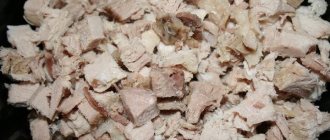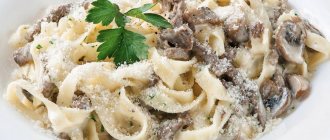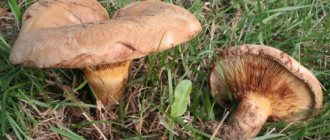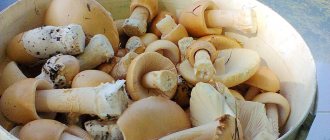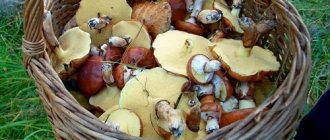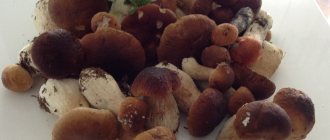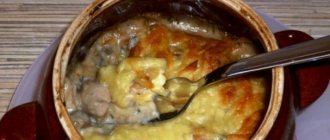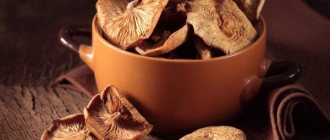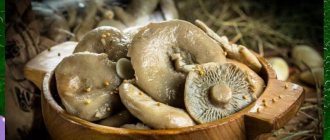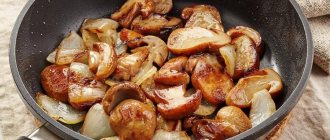How to process and prepare boletus at home and according to good recipes?
Even if you are an experienced mushroom picker and know how to process and prepare boletus, you will want to improve your knowledge in the field of processing mushroom crops and gain new experience. Beginners in this matter will find all the necessary information for themselves and learn how to correctly apply it in practice.
What do boletus look like?
For those who are going mushroom hunting for the first time or are improving their knowledge, it would be a good idea to learn what false and edible boletus mushrooms look like, how to distinguish them from other subspecies and not confuse them with toadstools.
- The true butterdish with yellowish flesh grows from May to November and has no duplicates.
- The red oiler has a cap of a characteristic color with a reddish tint.
- The goat or dry oiler appears in August and does not require cleaning the cap.
- The yellow-brown mushroom has a velvety cap with small scales.
- The grainy oiler is covered with small droplets of juice on the porous part.
- Remarkable boletus is covered with large red-brown scales.
- The Siberian oiler with a dirty yellow or yellow-olive cap is well recognizable.
- The gray butterdish turns blue when cut and has a white ring on the stem.
- A wide ring frames the stem of the tawny oiler.
- The ruby butterfly differs from other mushrooms in its bright color palette.
- The cap of the painted oiler is covered with scales, and the flesh turns red when cut.
- The leg of the larch oiler is surrounded by a yellow ring.
- Cedar oiler has a bright fruity-almond aroma.
- The yellowish oiler can be recognized by its mucous ring.
- The white oiler differs from the boletus in the color of its cap.
- The Bellini mushroom has a massive stalk and a light brown cap.
- Numerous varieties of boletus have practically no false counterparts - toadstools. Only the conditionally edible pepper mushroom can be mistaken for the desired mushroom.
- Very edible spruce fly.
Edible types of oil cans
Ordinary oiler. This species is the most common in Russia. The hat is flat with curved edges. There is a noticeable bump in the center. Color brown.
The pulp is very juicy. The leg is solid, white. The older the mushroom, the darker it becomes. In very old fruits, the stem becomes dark brown. Its height varies within 10 centimeters.
The species is found almost everywhere, but its favorite place, as with any mushroom, is coniferous areas.
Ideal conditions for the development of a species family:
- Sandy soil.
- Good drainage.
- Dampness.
- Air temperature from +18 degrees Celsius.
It grows between July and October.
Larch oiler. It got its name due to the fact that it can most often be found in the larch habitat area. The mushroom is edible, but the taste is simple, without any aftertaste.
Main characteristics of the mushroom:
- A convex cap that becomes flatter as it ages. Its color is very bright. Fruits of a bright yellow, orange, or less often, dark brown hue may be found.
- The pulp is dense, yellow in color. When a young mushroom is damaged, its color does not change. If you damage an older fruit, then it will acquire a pinkish or reddish tint.
- The leg resembles a mace. Sometimes it has a curved shape. Height up to 12 centimeters, thickness does not exceed 3 centimeters. The color of the ring is white/yellow, less often brown.
The oiler is grainy. Also a very popular look. It tastes good. Unlike other butterfish, this species does not have a ring on the stem.
Main characteristics of the mushroom:
- The cap is convex, small, with a diameter of 4 to 10 centimeters. In dry weather it sparkles in the sun. When it rains, the mushroom becomes slimy. The skin color is brown, yellow-orange, less often burgundy.
- The pulp is dense, yellow in color. Smells like hazelnut. Does not change color when damaged.
- The leg is dense, cylindrical in shape, light yellow in color. In older mushrooms, it turns dark brown closer to the root. The leg acquires this shade due to the fact that the mushroom secretes juice. It is no more than 8 centimeters in height and 1.5-2 cm in thickness. On the surface of the stem there are often granular formations, which is, in fact, how the mushroom got its name.
These are not all types of this mushroom. There are also others, however, less common in the Russian Federation. These are: white, yellow-brown, gray, American and swamp oiler.
How to clean boletus?
Having learned to recognize a mushroom in the forest, it won’t hurt to learn how to quickly clean boletus.
- Mushrooms should be cleaned within the first few hours after picking. It is preferable to do this dry, starting to wash the mushroom mass after cleaning.
- The easiest way is to pry the edge of the film with a knife and remove it from the cap.
- You can make it easier to remove the film by dipping each cap in boiling water for a few seconds and then cleaning it immediately.
- Without a knife, you can peel the mushroom if you break it in half, then move the two halves of the cap apart and remove the film.
Preparing oil for processing
First you need to stock up on tools. To clean debris and dirt you will need a small knife, for sorting - one or 2 basins or paper and 1 basin, as well as rubber gloves.
Cleaning mushrooms
The oily skin makes peeling especially difficult. Is it worth cleaning it up? Due to its characteristics, the mucous film accumulates a lot of excess debris, radiation and toxic substances. And despite the many beneficial properties of the oil can, people often decide to get rid of it.
Cleaning guarantees that in the mushroom soup you will not see any debris, worms, or insects hiding under the plates, and you will not feel the unpleasant crunch of sand on your teeth.
It is recommended to clean the caps and legs in several stages. Next, it is proposed to act in accordance with the recipes.
Cleaning up in the forest
It is impossible to collect absolutely pure boletus in the forest. Due to their sticky surface, wind and humidity after rain, soil, leaves and fallen spruce branches fall on the caps and legs. Processing of oilseed after collection is optionally carried out immediately in the forest. This way there will be less work left at home.
After assembly, remove leaves and twigs. Heavily adhered debris should be scraped off with a knife. If the mushrooms have holes, they are cut out until dense, good-quality pulp appears. To make sure there are no worms, the mushroom is cut into two parts.
Attention! When cutting, it is recommended to use a stainless steel knife, otherwise the mushroom may turn black.
Next, we carry out more thorough cleaning at home.
Processing oil at home
Mushrooms tend to spoil quickly, so cooking should not be delayed. Usually the whole process takes 3-4 hours after collection - this way the boletus does not have time to disappear.
How to process mushrooms:
- First, you need to pre-sort them: for winter preparations and for cooking on the same day.
- To avoid darkening, place in a well-ventilated area or fill with salted cold water before cleaning.
- Rinse under cool running water what was selected for cooking, stewing, salting and frying.
- Butternuts with damaged caps should be thrown away, and if there are holes on the stem or small areas, they should be cut out.
- It happens that the dirt eats away strongly - it is worth going over such mushrooms with a brush with small soft bristles. If the soil is stuck much deeper, cut off these areas in thin layers with a knife. The legs also need to be cleaned of soil.
- Then dry the mushrooms by placing them on a wooden surface.
- The workpiece intended for drying for the winter does not need to be washed. You should rid the surface of the butter from dirt and cut them into pieces.
Note! Before adding water, be sure to remove the sticky skin from the caps. When soaked for a long time, unpeeled butternuts quickly absorb liquid. Watery mushrooms become so slippery that it becomes almost impossible to remove the film from them.
Why remove the film from oil
The presence of skin and mucous film on boletus does not spoil their taste at all. But to give an aesthetic appearance, they are still removed.
Additional Information! The famous mycologist, Mikhail Vishnevsky, explains that such a procedure before cooking is completely optional, moreover, “mushroom mucus normalizes digestion and improves peristalsis.”
If your task is to prepare a beautiful dish, it is better to clean the butter from the film and skin. This way, dark and yellow shades will not be noticeable. And after boiling, the color is retained and no mucus is released.
Another reason for removing the film is for convenience during cooking. When frying, the film sticks to the wall of the pan, and the mushroom body loses its shape. The correct solution would still be to remove the sticky surface.
How to wash your hands after eating butter mushrooms?
After cleaning mushrooms without gloves, your hands become covered with a brown coating that is difficult to wash off. Find out the recommendations in the next section on how to wash your hands of oil.
- Citric acid will help you easily deal with contamination, which you can simply apply to moistened palms and rub a little or prepare a bath. To do this, dissolve a sachet of the substance in a liter of water and dip your hands into the solution for 10 minutes.
- Instead of citric acid, 9% table vinegar is suitable, pour a glass of it into a liter of water and hold your hands in the solution for 5 minutes.
- You can clean dark areas using nail polish remover with acetone or a paste of baking soda and water, which is used to wipe the stains with a cotton swab.
- Remains of dirt are washed off with laundry soap, and then lubricate your hands with cream.
Cleaning mushrooms
Let's find out what to do with boletus. They need to be cleaned in any case, since dust and various harmful substances settle on the cap, and the skin is often bitter, which greatly affects the taste of the future dish. The easiest way to clean is with a sharp knife. This method is often used, but it takes a lot of effort and time.
You can speed up the cleaning process using heat treatment. That is, you need to boil the mushrooms for no more than 30 seconds, after which the skin will peel off the cap itself. Sometimes you just need to remove it with your hands, and then be sure to wipe the cap. This method is noticeably faster.
Reference! If you keep the mushrooms in water longer, they will soften and later turn into a homogeneous mass.
How to cook boletus mushrooms?
Butter dishes delight the eye with variety and satisfy the taste needs of consumers with the most varied tastes. Collected, peeled and boiled mushrooms are an excellent basis for obtaining salted, appetizers, first and second culinary compositions.
- Butter is fried in a frying pan just like that, with onions or other ingredients.
- Mushrooms are added to soups, cooked with potatoes, complemented with all kinds of stews, stews, fish, seafood, and used as a filling in baked goods.
- A significant share in cooking is the preparation of butter for the winter in the form of pickles, pickled snacks or multi-component preparations with vegetables.
Salad with fried butternuts
A wonderful salad appetizer that you are not ashamed to offer to guests. Simple, fast, original.
You will need:
- Fresh boletus – 200 gr.
- Bell pepper – ½ part.
- Red onion - half a head.
- Potatoes – 2-3 tubers.
- Olive oil – 2 large spoons.
- Sunflower oil - the same amount.
- Salt.
How to cook:
- Rinse the potato tubers; there is no need to peel them. Place in the oven for 35-40 minutes at 180 o C, or bake in the microwave.
- Then peel and chop into small cubes.
- While the potatoes are cooking, fry the peeled and chopped fresh boletus in a frying pan in a small amount of oil. Frying time – 15-20 minutes.
- Chop the red onion into small cubes. Cut out the stem of the bell pepper and remove the seeds. Cut the pulp into cubes the size of potato slices.
- Place the prepared ingredients in a salad bowl, season with olive oil and add salt. Stir and bring to the table.
How to fry butter?
Fried boletus is a recipe for the simplest mushroom dish, which can be served simply with bread, or complemented with boiled or fried potatoes, boiled buckwheat, other grains, and pasta. At the end of frying the mushrooms, you can season them with chopped garlic cloves and finely chopped fresh herbs.
Ingredients:
- boletus – 500 g;
- onions – 2 pcs.;
- vegetable oil – 4 tbsp. spoons;
- salt pepper.
Preparation:
- The butter is cleaned, washed, cut into pieces if necessary and boiled in salted water for 10 minutes.
- Place the mushroom mass in a colander and allow the water to drain.
- Fry the onion in oil until half cooked.
- Add mushrooms and cook until lightly browned.
- Fried butter with onions is served piping hot or cooled.
Useful tips and lifehacks
Mushroom pickers are happy to share their experiences:
- If you freeze boletus, you can significantly increase its shelf life.
- Only gloves can completely protect the skin from mushroom juice; you need to take care of them before going into the forest and during processing (you won’t have to wash your hands for a long time).
- Fresh boletus does not last long, so processing must be done no later than 12-14 hours.
- If dried mushrooms begin to get soggy, it is useful to dry them in the oven.
- It is better to freeze collected mushrooms of one size, so they will take up minimal space in the freezer. It is recommended to cut large ones into pieces.
- After thawing, the butter body is no longer able to maintain its shape. Avoid constant frost. If you take mushrooms out of the freezer, cook them immediately.
The proposed methods and tips will help you not only enjoy the “quiet hunt”, but also not get your hands too dirty. With boletus, you have the opportunity to carry out your own experiments, and for this it is important to properly clean these gifts of the forest.
Fried butter with potatoes - recipe
Having learned how to process and cook boletus, you will be able to make a delicious, hearty dinner by frying mushrooms along with potatoes, young or more mature. If you are confident in the excellent quality and freshness of the butter, you can not boil it first, but immediately use it for frying with chopped vegetables.
Ingredients:
- boletus – 250 g;
- onions – 2 pcs.;
- potatoes – 1 kg;
- salt, pepper, vegetable oil.
Preparation:
- Fry the onion in oil until half cooked.
- Add prepared peeled, washed and chopped butter and fry with stirring until almost done.
- Add peeled and chopped potatoes.
- Fry the boletus with potatoes until they are ready, salt, pepper and serve.
Butter with potatoes, cheese, sour cream, baked in the oven
Another variation of baking mushrooms in the oven, more festive. The casserole with a cheese crust will turn out incredibly appetizing and aromatic.
Take:
- Fresh mushrooms – 400 gr.
- Potatoes – 1 kg.
- Sour cream – 100 gr.
- Parmesan – 100 gr.
- Bulb.
- Butter - a piece.
- Cream – 50 ml.
- Pepper, salt.
Preparation:
- Boil the potatoes in advance. Mash into a puree with a piece of butter.
- Cut the onion into cubes, start frying by adding a couple of tablespoons of butter to the pan.
- Then add the peeled and chopped boletus. Fry together for 15-20 minutes.
- Pour in the cream, add sour cream, add salt. After boiling, simmer over low heat for 3-5 minutes. Turn off the burner and cool.
- Grease a heatproof dish. Make a bottom layer of mashed potatoes. Place butter on top.
- Grate the cheese with coarse shavings and sprinkle the workpiece.
- Bake at 200 o C, turning on the timer for 20 minutes.
Mushroom caviar from boletus
Cooked boletus caviar will have an indescribable rich taste and bright aroma of wild mushrooms. The presented laconic composition of the snack can be expanded if desired by adding carrots poached in oil, crushed peeled tomatoes, sweet bell peppers or spices to your taste.
Ingredients:
- boletus – 1 kg;
- onion – 800 g;
- garlic – 1 head;
- sugar, ground black pepper - 1 teaspoon each;
- salt – 1.5 teaspoons;
- cloves, laurel, peppercorns.
Preparation:
- The mushrooms are cleaned, boiled, and twisted through a meat grinder.
- Chop the onion in the same manner and simmer in a frying pan until excess moisture evaporates.
- Add twisted boletus and simmer for 1 hour.
- Season the mixture with salt, pepper, sugar, stir in chopped garlic, and heat for 3 minutes.
- Place the hot mixture in sterile jars, placing laurel, pepper, and cloves on the bottom.
- Cover the containers with lids and store the caviar in the refrigerator.
Boletus collection season: the best time for “silent hunting” (with video)
[includeme file=”wp-content/plugins/include-me/goog-right.php”]
The time for collecting boletus depends on the climate of a particular area. So, sometimes it happens that the first mushrooms may appear in early spring - in April. After all, all they need for fruitful growth is light, warmth and moisture. However, traditionally, the boletus harvesting season begins in late May - early June, and continues until late autumn. It must be said that after heavy rains, the oil can grows very quickly - in just 10-15 hours, a forest edge flooded with sunlight can be filled with a whole family of fruiting bodies. Of course, September is considered the most favorable time for harvesting mushrooms. It is noteworthy that boletus is very resistant to changes in night and day air temperatures.
It is important not to miss the collection time, since boletus is a favorite delicacy for worms. Therefore, it is better to “hunt” for young mushrooms that insects have not yet taken a liking to. Below is a video of collecting boletus, clearly demonstrating when, where and how to do it correctly:
Butter soup
Fresh butter soup can be cooked with noodles, rice, buckwheat, other cereals, or in a purely vegetable composition, adding green peas, corn, sweet bell peppers and other vegetables as a filler. The taste and aroma of the hot dish will become even richer if you add a chopped stalk of celery to the frying.
Ingredients:
- boletus – 0.5 kg;
- potatoes – 3 pcs.;
- onions and carrots - 1 pc.;
- vermicelli – 1 handful;
- laurel, pepper;
- greens – 0.5 bunch.
Preparation:
- Cut the peeled potatoes, add water and boil until almost done.
- Add vermicelli and fry onions, carrots and pre-boiled mushrooms.
- Season it hot, boil it a little, season it with herbs, let it brew for 20 minutes.
How to cook butter before frying, freezing, or pickling?
Preparing mushrooms for subsequent processing is simple and does not take much time. To do everything correctly, you should follow these recommendations:
- Before frying, you don’t even have to boil the mushrooms. But if you have doubts about the quality or freshness of the product, it’s worth doing. In this case, put the components in water, bring to a boil and hold for 5 minutes. Then change the liquid to fresh one and cook the butter for another 10-15 minutes.
- Products intended for freezing also do not require cooking. True, in cases where you need to do something with a large volume of product, boiling it can help. Before putting the boletus in the freezer, they are kept in boiling water for a quarter of an hour. They will not reach readiness, but will decrease slightly in volume. Now they can be placed in plastic bags or containers, forming compact briquettes.
Before marinating, boil the mushrooms for 20 minutes. But first they are kept in boiling water for a quarter of an hour, the water is drained and replaced with new one. Another 5 minutes of boiling, this time in salt water, and the products are washed with clean water. The component is ready for further processing.
If you need to make soup from butternuts, then they are simply added as the first component on the basis of which the broth is prepared. After 5 minutes of boiling, the first water should be drained, the second liquid will still be quite rich and aromatic.
Mycelium from boletus - recipe
Butter mushroom is a thick type of rich mushroom soup that is thickened by adding beaten eggs or adding cheese. The basic vegetable set consists of chopped potatoes, onions and carrots, but it is not forbidden to use other vegetable components of your choice and taste.
Ingredients:
- boletus – 0.5 kg;
- potatoes – 400 g;
- onions and carrots - 1 pc.;
- processed cheese – 250 g;
- garlic – 2 cloves;
- laurel, pepper, salt, vegetable oil;
- greens – 0.5 bunch.
Preparation:
- Mushrooms are cut and boiled in water for 20 minutes.
- Add potatoes, onions and carrots fried in oil.
- After 10 minutes, add cheese, garlic, and seasonings to the pan and boil for five minutes.
- Serve hot mycelium with herbs.
Butter fried in sour cream
Cooking butter mushrooms in sour cream reveals the taste of wild mushrooms as clearly as possible. You can also use heavy cream and stew the dish in it after frying the ingredients. For those who prefer more savory snacks, you can add chopped garlic and finely chopped fresh herbs at the end of the stew.
Ingredients:
- boletus – 0.5 kg;
- onions – 2 pcs.;
- sour cream – 150 g;
- salt, pepper, vegetable oil.
Preparation:
- The butter is prepared, boiled for 25 minutes, and drained in a colander.
- Fry chopped onions in vegetable oil until half cooked.
- Add boiled mushrooms and fry until lightly browned.
- Add sour cream, season the dish with salt and pepper, and simmer for several minutes.
Composition and calorie content of marinated butter
In the photo there are marinated boletus
Mushrooms are a low-calorie product, and this will definitely be appreciated by those who adhere to a particular diet. A tasty snack can be introduced into it without problems and thereby diversify.
The calorie content of pickled butter is 18 kcal per 100 g, of which:
- Proteins - 3 g;
- Fats - 0.5 g;
- Carbohydrates - 1.4 g.
The product is rich in dietary fiber and also has a good vitamin and mineral composition. Butternuts contain B vitamins and various minerals, especially zinc and copper.
Vitamins per 100 g:
- Beta carotene - 0.0343 mg;
- Vitamin B1, thiamine - 0.03 mg
- Vitamin B2, riboflavin - 0.27 mg;
- Vitamin B6, pyridoxine - 0.3 mcg;
- Vitamin B9, folate - 30 mcg;
- Vitamin C, ascorbic acid - 12 mg;
- Vitamin E, alpha-tocopherol - 0.0002 mg.
Macroelements per 100 g:
- Potassium - 60 mg;
- Calcium - 0.76 mg;
- Silicon - 2.1 mg;
- Magnesium - 5.49 mg;
- Sodium - 2.25 mg;
- Phosphorus - 23.3 mg;
- Chlorine - 1.1 mg.
Microelements per 100 g:
- Aluminum - 368.1 mcg;
- Boron - 1.5 mcg;
- Vanadium - 0.5 mcg;
- Iron - 1.3 mg;
- Iodine - 5 mcg;
- Lithium - 5.4 mcg;
- Manganese - 0.0445 mg;
- Copper - 1456 mcg;
- Molybdenum - 0.77 mcg;
- Nickel - 6.4 mcg;
- Rubidium - 225.8 mcg;
- Selenium - 5.6 mcg;
- Chromium - 5.3 mcg;
- Zinc - 14 mg.
Despite the fact that during cooking some of the beneficial components are lost, quite a few vitamins and minerals remain in the pickled butter. 100 g of fresh mushrooms contain more than 120 and 150% of the daily dose of zinc and copper, respectively. During cooking and pickling, about 25-60% will be lost, but even with the highest losses, the product will remain a good source of these minerals.
In addition, it is important to note that the product contains valuable polysaccharides, and the amino acid composition of the butter protein is very close to complete animal protein
Preparing butter for the winter
Recipes for preparing pickled or salted mushrooms in jars or barrels will help you prepare boletus for the winter. To store the latter, you will need a cellar, a cool basement or free space in the refrigerator. Crispy mushrooms are served with butter, chopped onions, garlic or used in cooking.
Ingredients:
- boletus – 1 kg;
- salt – 2.5 tbsp. spoons;
- onions and carrots - 1 pc.;
- laurel – 5 pcs.;
- garlic – 4 cloves;
- peppercorns, currant leaves and dill.
Preparation:
- Boil the peeled boletus in salted and slightly acidified water for 25 minutes and drain in a colander.
- Place the mushrooms with their caps down, sprinkling the layers with salt, herbs, garlic and spices.
- Press the mushroom mass with a weight and leave for 24 hours.
- Place the pickles in jars along with the brine, cover with lids, and place in the refrigerator.
Basic methods of homemade pickling oil
You can pickle boletus mushrooms using traditional cold and hot methods, combining them with fermentation or pickling. In order not to interrupt the natural mushroom taste and aroma, it is better to use spices in minimal quantities or avoid them altogether. coarsely ground stone salt We offer you several simple recipes that our mothers and grandmothers used to make the preparations.
Pickled boletus
Fermentation, which occurs during the process of lactic acid fermentation, allows you to do without additional preservatives and gives mushrooms (vegetables and fruits) a special nutritional value and a pleasant sour taste.
Number of servings/volume: 4 l
Ingredients:
- butter (boiled) – 5 kg;
- rock salt – 250 g;
- sugar – 80 g;
- whey – 2-3 tbsp. l.
Optionally you can add:
- allspice and black pepper (peas) – 15-20 pcs.;
- bay/oak leaf – 5-10 pcs.
Cooking technology:
- Place the mushrooms, washed and drained after boiling, into a clean, dry (enamel, glass, ceramic or wooden) container.
- Prepare the filling at the rate of 3 tbsp. l. salt and 1 tbsp. l. sugar per 1 liter of water: bring the water in the pan to a boil, add salt and sugar, stir until the spices are completely dissolved. Cool to 40 ℃ and add whey.
- Pour warm brine over the mushrooms, cover the contents of the container with a flat lid or plate on which you can place pressure.
- We leave the container with mushrooms in a warm room for 3 days, after which we put it in the cold for 1 month.
- To ensure the possibility of long-term storage, put the pickled butter in a colander, drain all the liquid from them and strain, rinse the mushrooms themselves under running water and let it drain.
- Place the mushrooms in sterilized jars. Bring the strained brine to a boil, removing any foam that appears with a slotted spoon, and pour it into jars with mushrooms to a level 1.5-2 cm below the top of the neck. If the filling is not enough, you can add boiling water.
- Place the jars, covered with lids, in a saucepan with hot water or in the oven and pasteurize over low heat: half-liter jars for 30-40 minutes, liter jars for 50-60 minutes. After this, immediately seal the jars tightly, check the quality of the closure, turn them over and leave until completely cooled.
If you do not have the opportunity to buy whey, then preparing it yourself is not difficult. To do this, take fresh (unboiled) sour milk or kefir, pour it into a saucepan, put it on the stove and heat it without bringing it to a boil. After clots appear, the mixture is allowed to cool and filtered through a sieve with a double layer of gauze. The flowing liquid is whey. Thus, you get two tasty and healthy products at once: homemade cottage cheese and fresh fermented milk whey.
Ready-made pickled butter is served as a delicious appetizer, sprinkled with chopped onions and flavored with vegetable oil, or added to various dishes.
Cold pickling oil in jars
salted butter can be prepared using the “dry” technology and not rolled, but closed in jars under a nylon lid and stored in the refrigerator. This preparation is convenient to use for preparing everyday dishes.
Number of servings/volume: 2-2.5 l
Ingredients:
- butter (boiled) – 3 kg;
- rock salt – 150 g;
- black pepper (peas) – 10-15 pcs.;
- allspice (peas) – 5-7 pcs.;
- garlic – 5-7 cloves;
- dill (umbrellas) – 5 pcs.;
- vegetable oil – 150 ml.
Cooking technology:
- Along the bottom of a capacious container, evenly distribute a handful of salt and some of the prepared spices: dill umbrellas, pepper, chopped garlic.
- Place the mushrooms caps down, sprinkling each mushroom layer with salt and spices.
- Cover the filled container with a plate or lid and place a weight on top.
- Leave the workpiece for a day in a warm place.
- We wash the jars of soda well, put the mushrooms in them and fill them with the released liquid.
- Pour a few tablespoons of vegetable oil into each jar so that it completely covers the surface, and seal the jars with nylon lids, preheated in boiling water.
- We put the mushrooms in the refrigerator and let them salt for 2-3 weeks.
Salted butter is tasty and aromatic, satisfying and nutritious, containing a large amount of vegetable proteins. They will become a real decoration for a regular, vegetarian or Lenten menu.
Quick salting oil using the hot method
Many housewives do not have the opportunity to store preparations in the refrigerator, cellar or basement, so they often have to pickle or salt butter for the winter in jars using a hot method .
Number of servings/volume: 2-2.5 l
Ingredients:
- butter (boiled) – 3 kg;
- water for brine – 1.5 l;
- rock salt – 3 tbsp. l.;
- sugar – 1.5 tbsp. l.;
- black and allspice peppers (peas) – 5-10 pcs.;
- bay leaf – 3-5 pcs.;
- dry cloves – 5-6 pcs.
Cooking technology:
- Place peeled, boiled and washed mushrooms in an enamel pan and fill with water. Place on high heat and bring to a boil.
- Add all the spices and spices to the pan. Boil the mushrooms in brine for 20-30 minutes.
- While the mushrooms are cooking, wash the jars with soda and sterilize them.
- Place the hot mushrooms in jars, fill them to the top with brine and seal them tightly with lids.
- Cover the inverted jars with a blanket and leave to cool. You can store such a workpiece under normal conditions in a pantry or kitchen cabinet.
Using the same technology, you can not only salt the boletus, but also marinate it by adding vinegar (9%) to the brine at the rate of 70-100 ml per 1 kg of mushrooms 5-10 minutes before the end of cooking.
Recipe for pickling butter
You can marinate boletus at home using acetic acid, table vinegar or citric acid, calculating the correct proportions of the additive. As a spicy assortment, use a classic mix of laurel and peppercorns, or add cloves, allspice, and cinnamon for added piquancy.
Ingredients:
- boletus – 2 kg;
- water – 1 l;
- salt – 1 tbsp. heaped spoon;
- sugar – 2 tbsp. spoons;
- vinegar 70% - 1 tbsp. spoon;
- garlic – 2-3 cloves in each jar;
- laurel, pepper, cloves.
Preparation:
- The butter is cleaned and boiled for 15 minutes.
- Boil water with added salt and sugar.
- Add mushrooms, let it boil, pour in vinegar.
- Place the mushrooms with the marinade in sterile jars, adding garlic, bay, peppercorns, and cloves to each.
- Seal the containers with lids and wrap them until they cool completely.
Popular recipes and necessary ingredients
Among the popular recipes, there are 3 main ones. They differ in the method of preparation and the necessary ingredients. So, popular recipes for cooking immediately after harvesting:
- fried boletus;
- marinated mushrooms;
- frozen boletus.
In any case, you will definitely need the mushrooms themselves, their quantity may vary, but recipes for 2 kilograms of butter will be written here. The remaining ingredients will be described in the recipes themselves, let's look at them in a little more detail.
How long to cook mushrooms?
Before preparing any recipe, butter must be cooked. This will reduce the concentration of harmful and dangerous substances that the oil can absorbed in the forest. They should be cooked immediately after cleaning:
- Place the mushrooms in a container and fill completely with water.
- Place the pan on the stove.
- Salt the contents and bring to a boil.
- As soon as the water boils, reduce the heat and cook for half an hour.
After time, the boletus should sink to the bottom. In any case, you need to pour them into a colander and leave them like that until next use. It is recommended to place them in the sink, as water will drain from them for a long time.
Important! The broth can be strained using a sieve and then used for soup.
How long to fry?
Many people love fried potatoes with mushrooms. The second ingredient is often boletus. This recipe is likely the most popular among those that use mushrooms.
To fry butter, you will need:
- 2 kg of mushrooms;
- 50 g vegetable oil;
- 1–2 onions;
- salt, pepper and herbs to taste.
How to fry butter:
- Boil (see the paragraph “how long to cook mushrooms”).
- Cut the onion into half rings.
- Fry it until a golden crust appears.
- Add butter to the onion and fry over medium heat for 15 minutes, remembering to stir.
- Simmer in the same frying pan, covered with a lid, for 8–10 minutes.
- Add salt, pepper and herbs to taste.
How to marinate boletus?
It is known that mushrooms do not grow in winter. But sometimes you want to eat them in winter. In order to fulfill this desire, boletus should be pickled in the summer. Fortunately, this is not so difficult to do.
You will need:
- 2 kg butter;
- 2 liters of water;
- 1 tbsp. l. 9% vinegar;
- 3 cloves of garlic;
- 3–4 tbsp. l. sugar and salt;
- 1 clove;
- 10 small peas of allspice;
- dill, preferably dried;
- Bay leaf.
How to marinate mushrooms:
- Boil (see the paragraph “how long to cook mushrooms”).
- Boil the butter again in new water with spices, salt, sugar and vinegar for 20 minutes.
- Sterilize the jars in which the mushrooms will be pickled (this can be done using steam or an oven).
- Prepare the marinade: add salt, sugar, cloves, pepper to new boiling water and boil for 5 minutes.
- Place butter in a jar.
- Fill the container with marinade so that all the mushrooms are in it.
- Cover the jars with a lid and leave in a dark, cool place until opening.
Freezing for the winter
Marinated mushrooms still differ in taste characteristics from ordinary ones. And many people want to make butter with cabbage in winter. In this case, you should simply freeze them without adding any spices.
Important! Frozen boletus cannot be stored for more than 1 year.
To freeze for the winter you need:
- Peel, rinse and boil (see the paragraph “how long to cook mushrooms”).
- Place the butter in a colander or on a towel and let the water drain.
- Pack into containers or other containers for freezing.
- It is recommended to indicate the date of freezing to monitor their shelf life.
Butter - frozen for the winter
When the preparations of butter in the form of pickles are made, you can freeze the remaining ones in the chamber if there is free space in it.
- The mushrooms are cleaned, washed, and placed in a pan for cooking.
- Add water so that it covers the mushrooms halfway.
- Bring the mushroom mass to a boil, add salt, pepper, bay, and other spices as desired.
- Boil the mushrooms for 30 minutes, drain in a colander, and leave to drain the moisture until completely cooled.
- Transfer the mushroom mass into freezer bags or containers and place them in the freezer for storage.
Do frozen butternuts need to be fried longer?
Fried boletus doing everything right!
It is better not to put frozen mushrooms directly into a hot frying pan, because... they can burn and ruin your meal. To avoid mushrooms burning in the pan, we advise you to defrost them in this simple way, and then fry them in the same way as fresh ones:
- Transfer mushrooms from freezer to refrigerator
- Wait until completely defrosted
- Rinse thoroughly
- Boil in clean water for 10 minutes (optional)
- Drain in a colander and allow excess water to drain.
